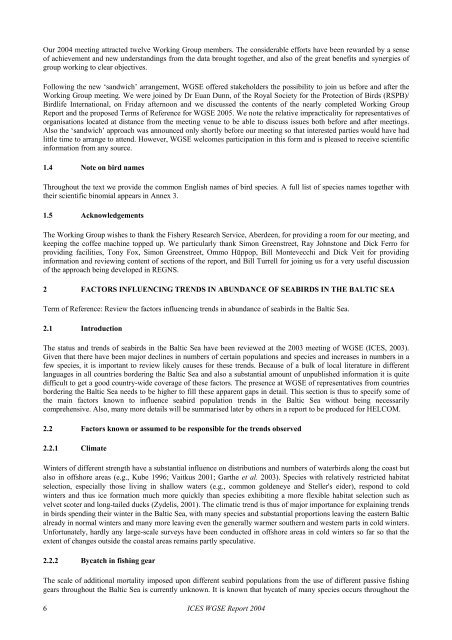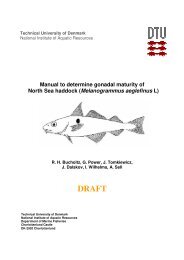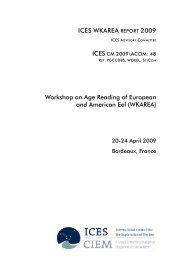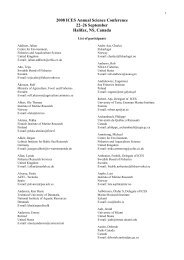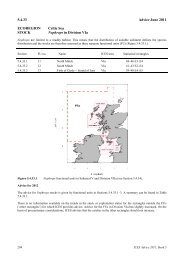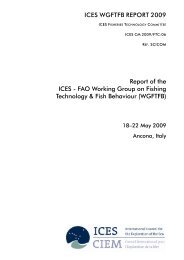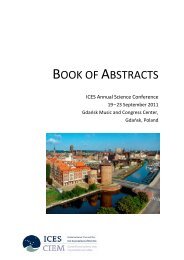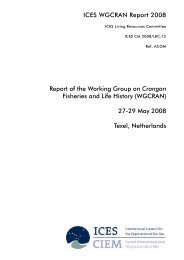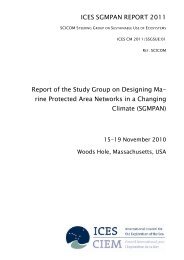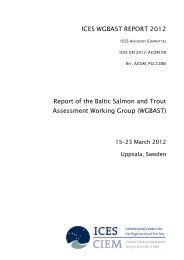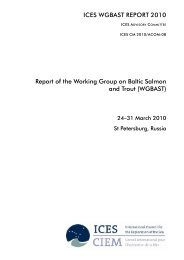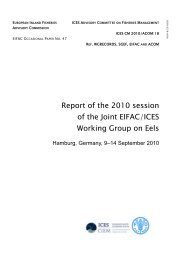Working Group on Seabird Ecology (WGSE). ICES CM 2004/C:05 ...
Working Group on Seabird Ecology (WGSE). ICES CM 2004/C:05 ...
Working Group on Seabird Ecology (WGSE). ICES CM 2004/C:05 ...
- TAGS
- seabird
- ecology
- ices
- www.ices.dk
Create successful ePaper yourself
Turn your PDF publications into a flip-book with our unique Google optimized e-Paper software.
Our <strong>2004</strong> meeting attracted twelve <str<strong>on</strong>g>Working</str<strong>on</strong>g> <str<strong>on</strong>g>Group</str<strong>on</strong>g> members. The c<strong>on</strong>siderable efforts have been rewarded by a sense<br />
of achievement and new understandings from the data brought together, and also of the great benefits and synergies of<br />
group working to clear objectives.<br />
Following the new ‘sandwich’ arrangement, <strong>WGSE</strong> offered stakeholders the possibility to join us before and after the<br />
<str<strong>on</strong>g>Working</str<strong>on</strong>g> <str<strong>on</strong>g>Group</str<strong>on</strong>g> meeting. We were joined by Dr Euan Dunn, of the Royal Society for the Protecti<strong>on</strong> of Birds (RSPB)/<br />
Birdlife Internati<strong>on</strong>al, <strong>on</strong> Friday afterno<strong>on</strong> and we discussed the c<strong>on</strong>tents of the nearly completed <str<strong>on</strong>g>Working</str<strong>on</strong>g> <str<strong>on</strong>g>Group</str<strong>on</strong>g><br />
Report and the proposed Terms of Reference for <strong>WGSE</strong> 20<strong>05</strong>. We note the relative impracticality for representatives of<br />
organisati<strong>on</strong>s located at distance from the meeting venue to be able to discuss issues both before and after meetings.<br />
Also the ‘sandwich’ approach was announced <strong>on</strong>ly shortly before our meeting so that interested parties would have had<br />
little time to arrange to attend. However, <strong>WGSE</strong> welcomes participati<strong>on</strong> in this form and is pleased to receive scientific<br />
informati<strong>on</strong> from any source.<br />
1.4 Note <strong>on</strong> bird names<br />
Throughout the text we provide the comm<strong>on</strong> English names of bird species. A full list of species names together with<br />
their scientific binomial appears in Annex 3.<br />
1.5 Acknowledgements<br />
The <str<strong>on</strong>g>Working</str<strong>on</strong>g> <str<strong>on</strong>g>Group</str<strong>on</strong>g> wishes to thank the Fishery Research Service, Aberdeen, for providing a room for our meeting, and<br />
keeping the coffee machine topped up. We particularly thank Sim<strong>on</strong> Greenstreet, Ray Johnst<strong>on</strong>e and Dick Ferro for<br />
providing facilities, T<strong>on</strong>y Fox, Sim<strong>on</strong> Greenstreet, Ommo Hüppop, Bill M<strong>on</strong>tevecchi and Dick Veit for providing<br />
informati<strong>on</strong> and reviewing c<strong>on</strong>tent of secti<strong>on</strong>s of the report, and Bill Turrell for joining us for a very useful discussi<strong>on</strong><br />
of the approach being developed in REGNS.<br />
2 FACTORS INFLUENCING TRENDS IN ABUNDANCE OF SEABIRDS IN THE BALTIC SEA<br />
Term of Reference: Review the factors influencing trends in abundance of seabirds in the Baltic Sea.<br />
2.1 Introducti<strong>on</strong><br />
The status and trends of seabirds in the Baltic Sea have been reviewed at the 2003 meeting of <strong>WGSE</strong> (<strong>ICES</strong>, 2003).<br />
Given that there have been major declines in numbers of certain populati<strong>on</strong>s and species and increases in numbers in a<br />
few species, it is important to review likely causes for these trends. Because of a bulk of local literature in different<br />
languages in all countries bordering the Baltic Sea and also a substantial amount of unpublished informati<strong>on</strong> it is quite<br />
difficult to get a good country-wide coverage of these factors. The presence at <strong>WGSE</strong> of representatives from countries<br />
bordering the Baltic Sea needs to be higher to fill these apparent gaps in detail. This secti<strong>on</strong> is thus to specify some of<br />
the main factors known to influence seabird populati<strong>on</strong> trends in the Baltic Sea without being necessarily<br />
comprehensive. Also, many more details will be summarised later by others in a report to be produced for HELCOM.<br />
2.2 Factors known or assumed to be resp<strong>on</strong>sible for the trends observed<br />
2.2.1 Climate<br />
Winters of different strength have a substantial influence <strong>on</strong> distributi<strong>on</strong>s and numbers of waterbirds al<strong>on</strong>g the coast but<br />
also in offshore areas (e.g., Kube 1996; Vaitkus 2001; Garthe et al. 2003). Species with relatively restricted habitat<br />
selecti<strong>on</strong>, especially those living in shallow waters (e.g., comm<strong>on</strong> goldeneye and Steller's eider), resp<strong>on</strong>d to cold<br />
winters and thus ice formati<strong>on</strong> much more quickly than species exhibiting a more flexible habitat selecti<strong>on</strong> such as<br />
velvet scoter and l<strong>on</strong>g-tailed ducks (Zydelis, 2001). The climatic trend is thus of major importance for explaining trends<br />
in birds spending their winter in the Baltic Sea, with many species and substantial proporti<strong>on</strong>s leaving the eastern Baltic<br />
already in normal winters and many more leaving even the generally warmer southern and western parts in cold winters.<br />
Unfortunately, hardly any large-scale surveys have been c<strong>on</strong>ducted in offshore areas in cold winters so far so that the<br />
extent of changes outside the coastal areas remains partly speculative.<br />
2.2.2 Bycatch in fishing gear<br />
The scale of additi<strong>on</strong>al mortality imposed up<strong>on</strong> different seabird populati<strong>on</strong>s from the use of different passive fishing<br />
gears throughout the Baltic Sea is currently unknown. It is known that bycatch of many species occurs throughout the<br />
6<br />
<strong>ICES</strong> <strong>WGSE</strong> Report <strong>2004</strong>


